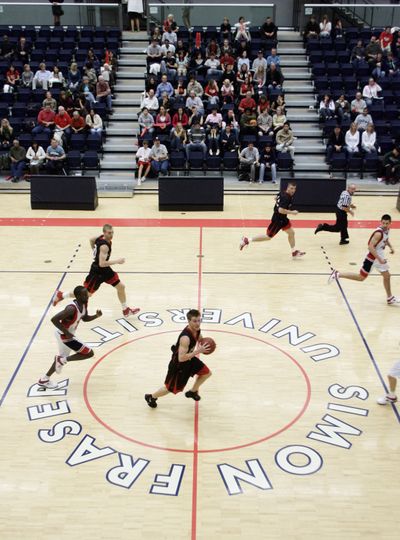Simon Fraser set to be first Canadian school in NCAA

BURNABY, British Columbia – Inside the gymnasium, the international lines forming trapezoidal keys on the basketball court are gone, replaced by the familiar rectangle and a pair of 3-point arcs.
The oddly long and wide lines – by American standards – on the turf football field are being torn apart and replaced by a 100-yard field with 10-yard end zones.
Simon Fraser University is almost ready to become the first Canadian member of the NCAA.
It’s just coming 12 months earlier than anyone expected.
“We have a unique situation. We are the only Canadian team playing in the United States,” Simon Fraser women’s basketball coach Bruce Langford said. “Therefore we kind of represent Canada, therefore there is a little bit more at stake.”
From the top of Burnaby Mountain, where the Simon Fraser campus sits, the views of the entire Lower Mainland surrounding metropolitan Vancouver are eye-popping: snowcapped mountains to the north and south, sea to the west, all framed by the towering firs of the Pacific Northwest.
But while the concrete campus at the top of the mountain provides views few can match, it’s the rest of Canadian college athletics that’s closely watching what happens at SFU.
When Simon Fraser hosts Western Oregon on Sept. 4 to begin the 2010 football season, the Clan will become the first Canadian team to play against U.S. competitors as a member of the Great Northwest Athletic Conference in NCAA Division II.
It’s part of a reclassification process that started in 2008 when the NCAA voted to accept membership applications from Canadian schools interested in joining Division II.
Simon Fraser, which held joint membership in the Canadian Interuniversity Sport system and the American-based NAIA, was the only school to move forward in the process.
Originally, the move to becoming the first Canadian NCAA member was to take place for the 2011-12 school year. That was before Canada West, SFU’s playing conference within the CIS, evicted the Clan beginning with this upcoming school year.
Already in the process of making the procedural changes to become an NCAA member, Simon Fraser’s timetable was dramatically accelerated. Schedules went from full to empty. The NCAA rulebook became required reading, as staff was hired earlier than expected to help with the transition.
Simon Fraser will compete in the 2010-11 school year as a provisional NCAA member.
“The real rule in Canada is there are no rules,” SFU football coach Dave Johnson said. “NCAA there is a rule for every angle, everything and we kind of knew that. It’s becoming more familiar with those rules.”
Most dramatic in the speed up was the impact on athletes. The CIS system allowed athletes five years of playing eligibility. But when Canada West kicked Simon Fraser out and the school announced last October it was heading south a year earlier than planned, numerous Simon Fraser athletes found themselves in the final days of their playing careers.
Langford’s women’s basketball program, a two-time defending CIS national champion, suddenly had just four returning players for the 2010-11 season. Johnson’s football team lost 60 players who either had finished four years of play or decided they wanted more than their one remaining year.
Additionally, a number of SFU athletes saw their remaining eligibility cut in half. Many athletes in Canada attend secondary schools following high school. Under the CIS system, those athletes still have five years of eligibility when they arrive at the university. But the NCAA views those years the same as attending a junior college.
“It was vindictive. That’s all I can say. There was no good solid reason why (Canada West) wouldn’t allow us to go this year,” Simon Fraser athletic director David Murphy said. “But it’s a blessing in disguise because it’s accelerated our ability to be compliant with NCAA rules and the fact GNAC accepted us.”
Ask those at Simon Fraser about the sudden change of plans, and while bitter about the believed slight from Canada West, there is also an air of excitement about the pending move.
When the school was constructed in 1965, the administration’s intent was that its athletic programs would play exclusively in the United States. That held true until 1997, when Simon Fraser’s competition in the Pacific Northwest made the move to the NCAA.
They found refuge in the CIS. But as the costs of competing in the CIS – namely travel across four provinces – continued to rise, Simon Fraser began looking for an outlet for all its programs.
The benefits are numerous for Simon Fraser. The travel costs drop significantly, with teams now able to take buses or short flights for most of their competitions.
The recruiting pitch now raises eyebrows among Canadian athletes. While those talented enough to compete at a high, Division I level aren’t going to change their plans, it’s the athlete who might be going south to play for a lower-level Division I or a high Division II program that Simon Fraser wants to target.
But it’s not just Canadian athletes who are the focus. The school has a strong case for American athletes to look north, with tuition comparable to out-of-state tuition for athletes in the states. The cost becomes an even better deal if the American dollar strengthens against the loonie.
“I think we can build something special here and we can be the flagship program in the nation,” Johnson said. “I think we can attract the best players from around the country. I’m an American guy but I can tote that Canadian maple leaf and talk about winning one for the country.”